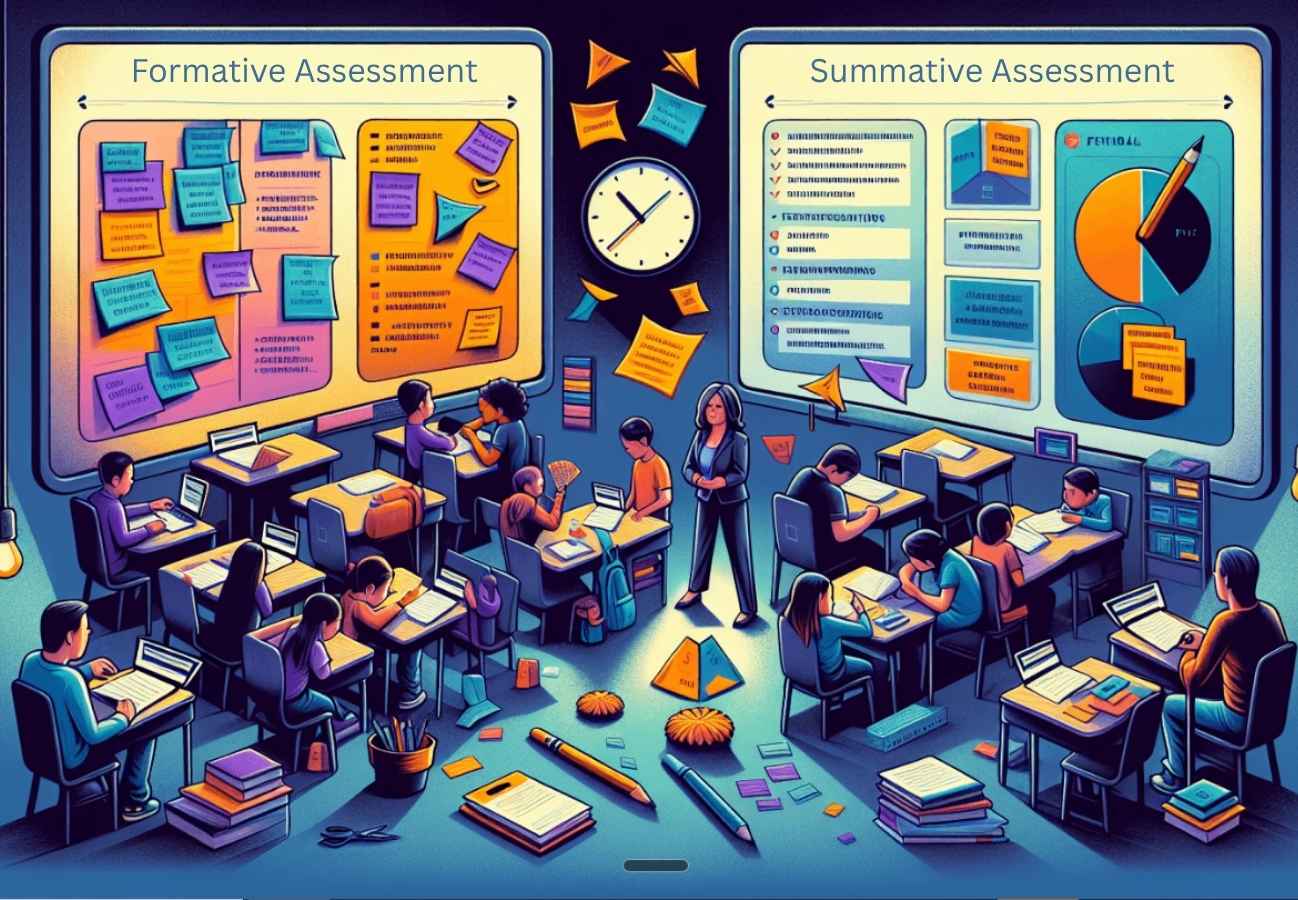Most teachers spend more time assessing students than teaching them. Yet despite constant evaluation, many students fail to master essential concepts.
The problem isn't too much assessment. It's using the wrong type at the wrong time. These two assessment approaches serve fundamentally different purposes, and understanding the distinction changes everything.
What Is Formative Assessment?
Formative assessment is evaluation during learning that guides instruction. It happens while students are still developing understanding and skills.
The purpose is diagnostic and instructional. Teachers gather evidence about what students understand, identify misconceptions, and adjust teaching accordingly. Students receive feedback that helps them improve before final evaluation.
Think of formative assessment as a GPS during a journey. It constantly monitors your position, recalculates when you take a wrong turn, and suggests better routes in real time. You're still traveling. The assessment helps you reach your destination more effectively.
Common examples include exit tickets, classroom discussions, observation notes, quick quizzes, think-pair-share activities, and digital polls. None of these typically count toward grades. All provide information that shapes what happens next in the classroom.
What Is Summative Assessment?
Summative assessment is evaluation after learning to measure achievement. It happens when instruction ends and you want to know what students learned.
The purpose is accountability and certification. Teachers document achievement levels, assign grades, and determine whether students met learning objectives. Results inform promotion decisions, report cards, and external reporting requirements.
Think of summative assessment as a destination photo. It captures where you arrived after the journey ends. The trip is over. The assessment documents your final position.
Common examples include unit tests, final exams, end-of-term projects, standardized tests, portfolios evaluated for grading, and performance assessments that demonstrate mastery. These count toward grades and create official records of achievement.
The Critical Distinction: Assessment FOR Learning vs Assessment OF Learning
The real difference isn't timing or format. It's purpose.
Formative assessment is assessment FOR learning. You use results to improve teaching and learning while both are happening. Information flows into immediate instructional decisions.
Summative assessment is assessment OF learning. You use results to document what students achieved after teaching ends. Information flows into grades, transcripts, and accountability reports.
The same task can serve either purpose depending on how you use it. A quiz becomes formative when you review results and reteach concepts students missed. That same quiz becomes summative when you record scores in your gradebook and move on.
This matters because most classrooms overuse summative assessment and underuse formative approaches. Teachers test frequently but rarely adjust instruction based on results. Students take quizzes that count toward grades but receive little actionable feedback for improvement.
The industrial model of education treats assessment primarily as quality control - sorting students into achievement levels. Formative assessment treats evaluation as an integral part of learning itself.
How Formative Assessment Works in Practice
Effective formative assessment transforms classrooms into responsive learning environments. Teachers gather evidence continuously and make instructional adjustments before misconceptions solidify or learning gaps widen.
The Formative Assessment Cycle
Good formative assessment follows a repeating cycle:
Plan: Identify the specific concept or skill you need to check. What exactly do you want to know about student understanding?
Gather evidence: Use a quick technique to collect information from all students, not just those who raise their hands. This might be an exit ticket, digital poll, whiteboard response, or observation during group work.
Analyze: Look for patterns. What do most students understand? What misconceptions appear repeatedly? Which students need extra support or extension?
Adjust: Modify your next lesson based on what you learned. Reteach if needed. Provide targeted support. Accelerate for ready students.
Repeat: Formative assessment isn't one-and-done. It's continuous throughout the learning cycle.
This cycle might happen multiple times within a single lesson. Quick formative checks provide constant feedback that keeps teaching aligned with student needs.
What Makes Formative Assessment Effective?
Not all formative assessment works equally well. Effective approaches share several characteristics:
Low-stakes environment: Students feel safe revealing what they don't know. Wrong answers provide valuable information rather than grade penalties. This requires deliberate culture-building around mistakes as learning opportunities.
Actionable feedback: Students receive specific guidance about how to improve, not just scores or vague praise. "Your thesis statement needs more specificity - try narrowing your topic to one aspect" beats "Good start, B-."
Timely response: Feedback arrives while students can still use it. Information from today's exit ticket shapes tomorrow's lesson. Waiting two weeks destroys the formative value.
Inclusive participation: The assessment captures thinking from all students, not just confident volunteers. Techniques like individual whiteboards, digital polling, or written responses ensure everyone's voice informs instruction. Explore participation strategies: Total Participation Techniques
Embedded naturally: The best formative assessment feels like regular learning activity. Students barely notice they're being assessed because the techniques integrate seamlessly with instruction.
Common Formative Assessment Strategies
Successful educators use diverse techniques throughout their lessons:
Exit tickets capture understanding at lesson's end with one or two quick questions. Students spend two minutes writing, you spend ten minutes that evening scanning responses and planning tomorrow's lesson.
Think-pair-share reveals student thinking through structured conversation. Listen as students explain concepts to partners. Their explanations expose both understanding and misconceptions. See more collaborative strategies: Cooperative Learning
Observation during work time provides rich formative data. Circulate with a clipboard and simple checklist. Note which students struggle, which concepts cause confusion, and which learners need extension.
Quick writes prompt students to explain their thinking in a few sentences. "Explain why we divide by the coefficient" or "Summarize the main cause of the conflict" reveals depth of understanding.
Misconception checks present common wrong answers alongside correct ones. Ask students which is right and why the others are wrong. Their reasoning shows whether understanding is solid or fragile.
For specific digital and analog tools that support these strategies, see our comprehensive guide: Formative Assessment Tools
How Summative Assessment Functions
Summative assessment serves accountability and certification purposes that formative evaluation cannot fulfill. These assessments provide official records of achievement, inform placement decisions, and satisfy external reporting requirements.
The Role of Summative Assessment
Summative assessment answers different questions than formative approaches:
Has this student mastered the required content? Unit tests and final exams document whether students met learning objectives.
What grade should appear on the report card? Summative results typically determine grades, providing standardized measures of achievement.
Is this student ready for the next level? Promotion and placement decisions rely on summative data about overall achievement.
How effective was our instruction? Summative results provide aggregate data about curriculum effectiveness and instructional quality.
These are legitimate purposes that schools must serve. The problem isn't that summative assessment exists. It's when summative approaches dominate at the expense of formative feedback that actually improves learning.
Types of Summative Assessment
Summative assessments take various forms depending on what you're measuring:
Traditional tests evaluate knowledge and skill through multiple-choice, short answer, and essay questions. These work well for measuring content mastery and procedural fluency but may miss deeper understanding. Learn more about designing questions at different cognitive levels: Bloom's Taxonomy
Performance assessments require students to demonstrate learning through authentic tasks - science investigations, historical research papers, mathematical modeling, artistic performances. These reveal application and transfer better than tests.
Projects and portfolios showcase learning over time through collected work samples. Students demonstrate growth and achievement through multiple products rather than single test performances.
Standardized assessments provide comparative data across classrooms, schools, and districts. These serve accountability purposes but rarely inform individual instructional decisions effectively.
The trend in summative assessment moves toward authentic tasks that mirror real-world applications. Students solve genuine problems and create meaningful products rather than simply recalling isolated facts.
What Makes Summative Assessment Valid?
Effective summative assessment requires careful design:
Clear criteria: Students know exactly what mastery looks like before the assessment. Rubrics, exemplars, and success criteria remove mystery from evaluation.
Curriculum alignment: The assessment measures what you actually taught. Surprise questions or skills students never practiced produce invalid results.
Multiple measures: One test on a bad day shouldn't determine a student's grade. Various assessment formats and opportunities reveal more accurate achievement levels.
Appropriate rigor: The assessment challenges students at the intended level. Too easy and it doesn't reveal mastery. Too hard and it measures frustration rather than learning.
Fair conditions: Students have reasonable time, appropriate accommodations, and clear instructions. Assessment measures learning, not test-taking endurance.
Comparing Formative and Summative Approaches
Understanding when and how to use each assessment type maximizes their educational impact. The approaches have complementary strengths that support comprehensive evaluation.
Timing and Frequency
Formative assessment happens continuously. Teachers might use three to five formative techniques within a single lesson. This constant feedback enables immediate instructional adjustments.
Summative assessment happens at predetermined intervals. Monthly unit tests, quarterly projects, or semester finals mark learning period conclusions. This timing allows comprehensive evaluation of accumulated learning.
The industrial model of education often reverses this pattern - rare formative feedback but constant summative testing. Students take weekly quizzes that count toward grades (summative) but receive little useful feedback for improvement (formative).
Stakes and Consequences
Formative assessment is low-stakes. Results don't affect grades. Students can safely reveal what they don't know without penalty. This encourages honest engagement and risk-taking.
Summative assessment is high-stakes. Results determine grades, placement, and sometimes graduation. This raises anxiety but serves necessary accountability functions.
Problems arise when everything becomes high-stakes. Constant grading transforms potentially formative assessments into summative ones. Students stop revealing gaps and start grade-gaming.
Feedback Quality
Formative feedback is specific and actionable. Students learn exactly what to improve and how. "Your evidence doesn't connect clearly to your claim - try explaining why this example matters" guides improvement.
Summative feedback is evaluative. Students learn where they stand. "85/100, B" documents achievement but doesn't guide future learning.
Both types of feedback matter. But confusion arises when teachers provide only evaluative feedback (scores and grades) without actionable guidance for improvement.
Who Benefits
Formative assessment primarily serves teachers and students. Teachers learn what to adjust. Students learn what to work on. This information drives improvement.
Summative assessment primarily serves external stakeholders. Parents want grades. Administrators need accountability data. Colleges require transcripts. These audiences need summative results.
The problem isn't serving external stakeholders. It's when external accountability demands dominate to the point where formative assessment for learning becomes impossible.
Building Balanced Assessment Systems
Effective assessment requires strategic integration of both approaches. This balance ensures continuous learning support while meeting legitimate accountability requirements.
Assessment Planning Principles
Start with learning goals, not assessment formats. What do students need to learn? What evidence would show they learned it? Then decide which assessment type serves your purpose.
Plan formative assessment into every lesson. How will you check understanding during instruction? Build quick checks directly into your lesson plans, not as afterthoughts. Explore more strategies: Teaching Strategies
Schedule summative assessment strategically. Too frequent summative testing overwhelms students and reduces instructional time. Space major assessments to allow teaching and learning between evaluations.
Make formative and summative assessments align. Formative checks should preview summative expectations. Students practice the thinking and skills they'll demonstrate on final assessments.
Use formative results to actually change instruction. Collecting data without acting on it wastes time. If your exit tickets show confusion, reteach tomorrow. If students mastered the concept, move forward.
What Balanced Assessment Looks Like
In classrooms with strong assessment systems:
Students receive frequent, low-stakes feedback that guides their learning. They know what they understand and what needs more work before summative evaluation.
Teachers adjust instruction based on evidence rather than assumptions. They reteach when students struggle, accelerate when students are ready, and differentiate based on actual needs.
Summative assessments measure learning that developed through formative feedback cycles. Students aren't surprised by final evaluations because formative assessment prepared them well.
Parents and administrators receive meaningful achievement data that reflects actual learning, not just compliance or test-taking skill.
Common Assessment Balance Problems
Most classrooms struggle with one of these patterns:
- Over-testing: Everything counts toward grades. Students are constantly evaluated but rarely receive feedback for improvement. Assessment dominates instructional time.
- Under-checking: Teachers deliver content without gathering evidence of understanding until unit tests. By then, misconceptions are entrenched and difficult to address.
- Feedback gaps: Teachers collect formative data but don't use it to adjust instruction. Exit tickets get filed, observation notes get ignored, and teaching proceeds according to plan regardless of student understanding.
- Mismatched stakes: Formative assessments count heavily toward grades, eliminating their diagnostic value. Or summative assessments don't reflect what students actually learned.
Assessment Challenges That Matter
Both assessment types present implementation obstacles that educators must navigate thoughtfully.
Time: The Universal Constraint
The most common complaint about formative assessment: "I don't have time."
This objection misses the point. Formative assessment doesn't add to teaching time - it makes teaching time more effective. Ten minutes checking understanding saves thirty minutes reteaching later.
The real time issue is systematic. When curriculum pacing guides demand coverage regardless of student learning, when standardized test preparation consumes weeks, when class periods are too short for meaningful work - these structural problems make good assessment impossible.
Formative assessment requires time to act on what you learn. Discovering that students don't understand fractions is useless if you must move to decimals tomorrow regardless.
Grading: The Persistent Confusion
Many teachers try to grade formative assessment. This destroys its purpose.
Once assessment affects grades, students stop revealing gaps. They stop taking risks. They game the system rather than genuinely engage. The information you receive becomes less honest and less useful.
But pressure to "have enough grades" pushes teachers toward constant grading. The solution isn't more graded assessments. It's fewer, better summative assessments that actually measure learning - supplemented by frequent formative feedback that improves performance before grading occurs.
Some progressive schools eliminate grades entirely in favor of narrative feedback and mastery-based progression. This aligns better with formative principles but challenges traditional reporting expectations.
Equity: Who Gets Assessed and How
Traditional summative assessment often privileges certain students - those who test well, speak English fluently, have stable home environments, and match cultural expectations embedded in assessments.
Formative assessment offers opportunities to address this. Multiple formats, low-stakes environments, and diverse response options allow more students to demonstrate understanding. A student who freezes during tests might excel at explaining concepts in conversation or creating visual representations. Explore approaches that center diverse learners: Student-Centered Learning
But formative assessment can also reproduce inequities. Cold-calling disadvantages language learners. Digital tools require device access. Group work assumes certain social skills. Thoughtful implementation requires attention to who participates and whose thinking you actually see.
Student Resistance: The Culture Challenge
Some students resist formative assessment because they've internalized performance culture. They want to know "Does this count?" If it doesn't affect their grade, they don't see why it matters.
This resistance reflects years of conditioning in assessment systems that value performance over learning, grades over growth. Changing this culture requires patience, consistency, and explicit conversations about why formative feedback helps them learn. Help students develop agency: Self-Learning
Where Assessment Practice Should Go
Assessment approaches continue evolving as educators discover more effective ways to support and measure learning.
Toward Competency-Based Systems
Traditional assessment measures time - how long students sat in class, when they took the test. Competency-based assessment measures actual mastery regardless of time.
Students progress when they demonstrate understanding, not when the calendar says so. This requires robust formative assessment to monitor readiness and flexible summative assessment that allows multiple attempts.
The approach aligns better with how learning actually works. But it challenges institutional structures built around seat time, age-based cohorts, and bell schedules.
Integrating Formative and Summative
The clearest assessment trend is blurring the line between formative and summative approaches. Portfolio systems, for example, collect student work over time (traditionally summative) while providing ongoing feedback that shapes learning (traditionally formative).
Digital platforms enable continuous assessment that serves multiple purposes simultaneously. The same task might provide formative feedback to students, summative data for reporting, and diagnostic information for instructional planning.
This integration reduces total assessment time while increasing useful information. But it requires rethinking how we conceive of assessment categories altogether.
For Educator Autonomy
The industrial model treats assessment as quality control - external agencies specify what to test and when. Teachers become test administrators rather than diagnosticians.
Professional assessment practice requires teacher autonomy. Educators need authority to assess in ways that serve their students' actual learning needs, not just external accountability demands.
This doesn't mean eliminating accountability. It means trusting teachers to gather evidence of learning in authentic ways rather than through standardized testing that narrows curriculum and distorts instruction.
For Learning That Transfers
Perhaps the deepest assessment question: What should we assess?
Most summative assessment measures content recall and procedural fluency. Students can pass tests without developing transferable understanding or applicable skills.
Future assessment should focus more on thinking processes, problem-solving approaches, and transfer to novel contexts. Can students use what they learned in new situations? Can they explain their reasoning? Can they identify when concepts apply? Learn about assessing cognitive complexity: Webb's Depth of Knowledge
These outcomes matter more than knowing isolated facts. But they're harder to measure with traditional tests. Authentic assessment formats - performance tasks, projects, applied problems - better reveal these deeper outcomes.
Assessment That Serves Learning
Assessment should serve learning, not just measure it.
Formative assessment makes teaching responsive and learning effective. Students receive feedback that helps them improve. Teachers adjust instruction based on evidence.
Summative assessment serves necessary accountability. Students need grades, schools need data.
But current practice inverts priorities. Schools devote enormous time to summative testing while formative feedback - the kind that actually improves learning - happens rarely.
The question isn't whether to use formative or summative assessment. It's how to balance them so assessment supports learning rather than just documenting it after the fact.









